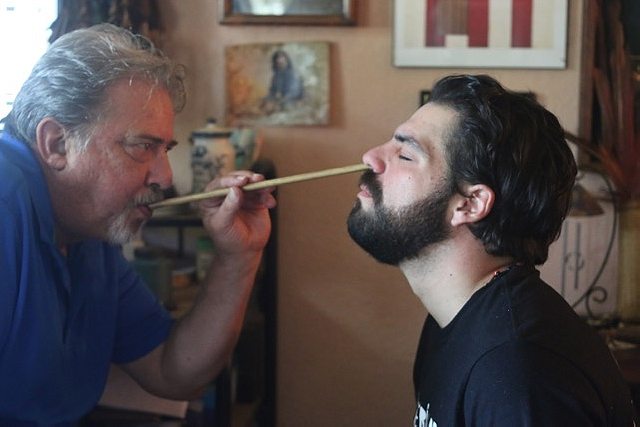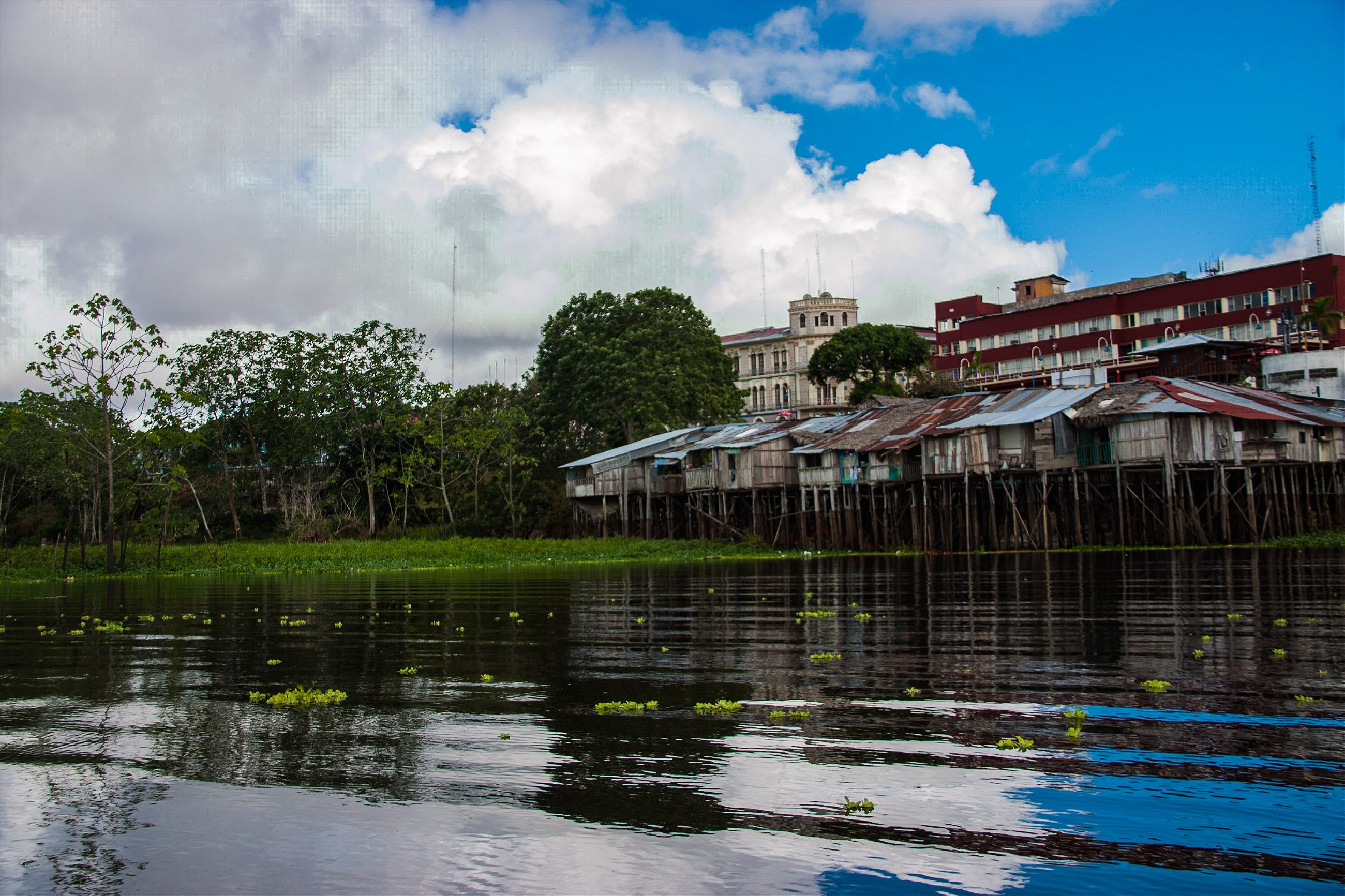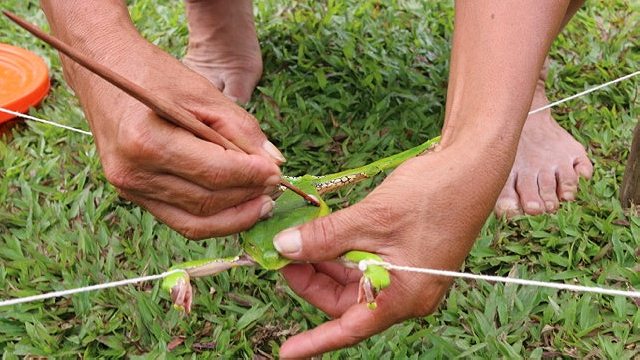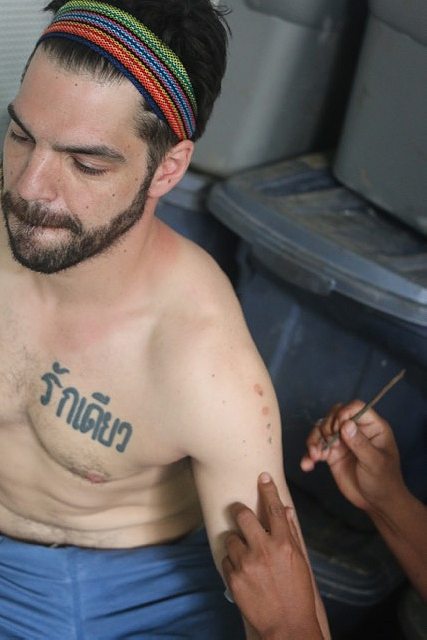You can take the psychedelic drug guru out of the jungle, but can you take the jungle out of the psychedelic drug guru?
I first met Peter Gorman in Iquitos, Peru. It was my third day there, and he was drinking water at a patio table on the malecón, the broad boulevard that separates the restaurants from the river. I was waiting for a friend and Gorman invited me to sit. Fifteen minutes later, he was blowing nu nu up my nose through a bamboo straw.
The first two blasts ricocheted off the back of my skull like a shotgun shell and forced streams of tears down my cheeks. The next two were subtle, and I barely felt the last two. Nu nu is a mildly psychoactive snuff used by the Matsés tribe in the Amazon rainforest. It is made from toasted, crushed, and powdered mapacho (jungle tobacco) and the burnt and powdered inner bark of the cacahuilo tree, a species of cacao. The heightened senses and clarity it provides the user are expected to improve a hunter’s luck.
The drug’s effects weren’t very strong, but the whole situation was ridiculous. I had just met this guy and already he was blowing some shit up my nose at a restaurant table. It continued in this vein when he told me to hold out my hands, then dumped a pile of fresh psychedelic mushrooms into them. “It looks like you met me on the right day,” he told me.

Three months later, I flew to Texas to meet up with Gorman at the home he shares with his family outside Fort Worth. My plane landed in Dallas while the temperature was pushing it’s way into the mid 90s. I had intended to rent a car upon landing in Texas in order to make the hour or so drive to Gorman’s house, but he insisted against it. And so, I found myself in the passenger seat of a navy-blue caravan with Chepa Gilma-Gorman, Peter’s ex-wife, driving down the I35 South.
As she drove, she talked about her family, her life growing up in the Amazon, and Gorman. Chepa is the love of Gorman’s life, the mother of his children, and an all-around badass woman, and I was grateful for the time alone with her. Chepa and Gorman met in Iquitos, which is touted as the largest city in the world not connected by road. If you want in or out, it’s a two-hour flight to Lima or a days-long boat ride to mainland Peru or the borders of Brazil and Colombia.
The locals call it Babylonia: a concrete jungle with the rainforest encroaching at the outskirts. An isolated Sodom and Gomorrah. Wander into any bar and you’ll meet outcasts, ex-special forces, pilots with questionable employers, and shamans—everyone and their mother is a shaman is this damn town—all of them draining bottles of cheap cold beer and railing off ridiculously tall tales.

In Iquitos, Gorman is something of a legend and a living hero, and spending time with him here is akin to drinking ether, getting high, and dropping acid with Hunter S. Thompson in the Rocky Mountains. Only this is the Amazon rainforest, so it’s nu nu, sapo, and ayahuasca. “Long before ayahuasca tourism became a pastime for rich gringos,” wrote Dennis McKenna, director of ethnopharmacology at the Heffter Research Institute, which studies hallucinogens, “Peter Gorman was knocking around Iquitos and the Amazon. He’s traveled the rivers and quaffed the brew with the best (and worst) of them and been way, way beyond the chrysanthemum on many a dark jungle night.”
Gorman spent 14 years working for High Times magazine, eventually serving as editor in chief, as well as writing for many other magazines; he has also spent over 30 years drinking ayahuasca and befriending his way through the jungle. His escapades led Penthouse magazine to compare him to Indiana Jones; he has hiked through the jungle from Peru to Brazil. He has lived with the Matsés, the Jaguar people and been attacked by vampire bats, pirates, and ill-intentioned brujos (witches). In Iquitos, he could reliably be found at his table on the malecón with a drink in hand and a small group surrounding him. Our riverside conversations ranged from drugs to politics to organized crime to plant medicines to football. I decided then and there that I wanted to know more about this guy, and about who he was when he wasn’t in this city of weirdos.

That’s why I found myself in the car with Chepa, three months after that initial meeting. As we rode, Chepa spun her own colorful stories for me. She explained that she and Gorman, along with their baby daughter Madeleine and two sons from her previous marriage, had moved back to Peru after a stint in New York in 1998. In Peru, Gorman led groups into the jungle almost full time, and the couple opened the Cold Beer Blues Bar by the commercial docks in Iquitos; Gorman had told me about the motley crew of characters that had frequented his bar and restaurant. Between the bar and his jungle trips, the work needed to keep both businesses running had begun to wear Gorman thin. After more than two years in Iquitos, they closed their bar and moved back to New York.
However, they discovered shortly thereafter that Chepa’s mother had been diagnosed with cancer. She was being treated in Lima and so the family made frequent trips back to Peru, periodically spending months at a time there over the following years. On one of those trips, with his marriage somewhat stressed, Gorman returned early to New York for work while Chepa stayed in Peru with their daughter. It wasn’t until almost a month later that Gorman discovered Chepa and Madeleine had left Peru without telling him and were staying in Fort Worth with Chepa’s sisters; they had fought before, but this time she had left him. Rather than go to court and fight for custody of his daughter, Italo and Marco—Chepa’s sons whom Peter had adopted and was raising— encouraged him to move to Texas to keep the family together.
“I had to move to Texas,” Gorman told me. “I figured I had to keep the family together, that was—is—the most important thing in the world to me. I had messed up a lot of things in my life and I wasn’t going to mess this up, even if it killed me.”
His intestines burst while in the Andes
It would be fairly incredible if marital strife was what finally did Gorman in. Since 1985, he has lived with periodically reoccurring malaria. He’s had a poisonous spider bite that went septic and opened up large holes in his arms in legs. His intestines burst while in the Andes, leading to an emergency operation in Cuzco, and then there’s his leg, swollen due to bacteria that had consumed much of his right front foreleg. It looked as if someone had pulled the cheese off a slice of deep-dish pizza. In Iquitos, he seemed genuinely worried about his leg. One late night, over glasses of rhum, he got emotional as he explained that the doctors were seriously considering amputation. Maybe it was just the liquor talking then, or maybe it really was healing, but later in Texas he was notably nonchalant about it. Granted, the swelling was all but gone, but the wound hadn’t closed very much and it still wept through the bandages he had to change more than once a day.
The day after I first met Gorman in Iquitos, I went back down to the malecón looking for him and found him at the same patio table drinking a tall glass of canazo, the locally distilled sugar cane rhum. I ordered a beer and our conversation turned to sapo: frog medicine. He is an expert on the stuff; he wrote the book on it, the recently published Sapo In My Soul. (His first book, Ayahuasca In My Blood, has reached a sort of cult status.) But everyone talks about ayahuasca now. We were talking about frog medicine. Sapo means toad in Spanish, although the drug comes from a frog, whose Latin name is Phyllomedusa bicolor, but is known by different names throughout the rainforest: monkey frog, Kambo, Kampo, and Sapo Verde, among others. It can be found in Bolivia, Brazil, Colombia, Peru, Venezuela, and the Guianas.
Employed in rituals by indigenous people along the border of Peru and Brazil, frog medicine is venom. To collect sapo the Phyll. bicolor frog is first caught, then gently tied to four small posts and agitated until its skin begins to secrete the venom in defense. With a small stick of bamboo, the frog’s back and legs are gently scraped and the stick is left to dry.
To use the sapo, a small flake is scraped from the stick and mixed with saliva until it reaches a thick consistency. The recipient is then burned with a small stick or vine, the burned skin is peeled away, and the liquified sapo is applied to the exposed capillaries. According to Gorman, every sense you possess is heightened and somehow in tune with the jungle, as though the sapo put the rhythm of the jungle into your blood.

The next morning, I anxiously arrived early at the house Peter was staying in, a faded blue and white mansion long past its days of grandeur. Down the wide, tiled hallway a small group had gathered in a room with chipped, pale-blue walls and white furniture. Peter sat with Jiro, grandson of a Julio, the curandero Peter had studied under for 20 years. A candle burned and Jiro lit a small piece of vine in its flame as Peter prepared the sapo and applied the goo to a thin stick. It looked like varnish. The seats were filled and everyone sat somewhat anxiously awaiting their initial burn.
When my turn came, the sensation of being burned was nothing compared to what I felt when the sapo entered my bloodstream. Some of the people in the room handled it quite well, stoic in their seats while the sapo ran its course. Others lay on the floor moaning, and some lost control of their bodily functions. For me, it was one of the most uncomfortable, difficult things to which I have ever intentionally subjected myself. The effects were incredible.
Immediately, I began to feel as if I had a fever. My body was burning. My heart began pounding and my hearing had begun to sound as if I were under water. My vision reduced to pinholes and fuzzy blurs of vague colors. My blood was racing and I began to sweat excessively even as I started to shiver. I became acutely, agonizingly aware of each and every part of my insides. My veins seared, my muscles ached, my stomach rolled and cramped violently, and I thought for a moment that my heart would burst. It was another 15 minutes or more until my immune system kicked into fight mode and I found myself purging harder than I ever had before.

I was later told that I was purging years of toxins that had been collecting in my body. It was discomfort on a level I’d never felt before. And then it was over. An hour after it all began the debilitating effects had completely dissipated. Although I couldn’t see in the dark, go days without food, or run for miles—as the Matsés claim sapo allows them to do—I did feel surprisingly strong and energetic over the following days. I noticed my breathing was effortless. Digestive issues I had dealt with throughout my life went into a long-term remission. I had explosive energy.
By most accounts, Gorman is the first non-indigenous person to bring sapo to the world’s attention. According to Laila Williamson, an associate at The American Museum of Natural History in New York City, “We don’t know whether Peter Gorman was the first outsider to use sapo, but as far as we know there is no earlier documentation than Gorman’s about an outsider using sapo.”
His research came to the attention of Vittorio Erspamer, a scientist and researcher at the FIDIA Research Institute of the University of Rome, who then requested a sample of the stuff to study in the lab. Gorman had given some of the material to the American Museum of Natural History in New York, along with other artifacts he had collected from the Matsés. He is credited as being one of the first people to work with the medicinal knowledge of the remote Matsés Indians, a semi-nomadic tribe living along the border of Peru and Brazil. The Matsés generally have two ways of dealing with outsiders, by either killing them, or integrating them into the tribe. Over the years, Gorman has been lucky enough to find himself in the latter category and has been able to spend extended periods of time within Matsés communities.

However, I spent my second day in Texas on a much less exotic exploration: running errands with Gorman and Taylor, his 5-year-old granddaughter. We stopped by a home-supply store where Gorman dropped off rented power tools, then headed to the liquor store. Gorman stops at the same store daily, and the clerk began ringing up a handful whiskey nips almost the moment we walked through the automatic doors. “I don’t keep a bottle around,” he said. “This is what I limit myself to daily.” We stopped at the market to pick up supplies for the grill that night: chicken, shrimp, and corn along with the ingredients for his homemade barbecue sauce. As we walked through the toy aisle, he let Taylor pick out a doll, then sheepishly steered her toward a less expensive one.
That night, while I manned the grill, Chepa and Gorman set the table for everyone: their daughters, daughter-in-law, granddaughters, and myself. Once we had all gathered around the table, he began to tell the story of how the couple had met.
They had been told there were pirates on the river who were willing to kill for a boat’s motor
He had he had been commissioned to do some medicinal plant collecting on the Yavari and Galvez rivers for Shamanic Pharmaceuticals. The Galvez was a second home to him by then; the Yavari, the border between Brazil and Peru, was another story. He was also hoping to contact the Matsés and bring back any artifacts they would give him for the American Museum of Natural History.
Gorman, Chepa, and a small crew had been heading down the river for four days. Night was falling when a boat came around a bend in the river. They had been told there were pirates on the river who were willing to kill for a boat’s motor. As the boat pulled up beside them, the two crewmen decided to take their chances with the pirates and boarded the other ship. Gorman told Chepa to hide below and readied himself for a fight. Gorman says that about ten men were on the boat, drunk and belligerent. Suddenly, Chepa reappeared beside him, asking what weapons he had. He told her he had a machete and a knife.
“‘We’ll now you have two machetes!’ and she starts yelling in Portuguese,” Gorman recounted with a laugh. After a lengthy shouting match, the pirates retreated. “Finally they got so bored,” he said. “They were too drunk or they got tired of us talking.” But Chepa had made a much stronger impression on him than the pirates.
“She was the most beautiful woman I had ever met,” he said.
“We were stupid,” she said with a smile. “You still are.”
“I told you I was going to marry you after that, and I did,” Gorman said, beaming at her proudly.
She laughed, told him again, “We were stupid then.”
“We still are,” he said.
That trip lasted 31 days and covered more than 1,500 river miles, and in the end, it proved very successful for Gorman. He was able to contact multiple Matsés communities, collecting artifacts. He gathered quite a few medicinal plants. And one year later, he and Chepa were married.

I woke up early the next morning with the hopes of taking sapo with Peter before I left, but my stomach was feeling upside down. And so, not sure it was actually the better idea, I opted for having a handful of nu nu blasted into each nostril. It burned like I had expected, and immediately the effects were notable. I found myself wondering if I should have opted for more sapo.
On the streets of Iquitos, I had causally brought up Gorman’s name in as many different social circles as I could, curious what others had to say about the man and his tall tales. You will hear a lot of different things about Gorman if you ask around in Iquitos. He is a natural storyteller, and he can be loud and overbearing at times. However, it was also clear that he really is a living legend and that many seek out his opinions and advice.
His house in Texas hosts a constant stream of vision seekers and those looking to learn about plant medicines. Is he crazy? I think so. Over the top? He does have 30-plus years of ayahuasca drinking under his belt. I don’t know if I’ve ever seen him without a cigarette in his hand and he curses with alarmingly casual frequency. In Iquitos, the man sure seemed larger than life: damn near unbelievable and certainly extravagant. But during my time in Texas with Gorman, other dimensions began to appear. In some ways, it began to seem that life had been larger than him all too frequently, and maybe he had just learned how to adjust and enjoy the ride.
[Cover image: Taco Witte]